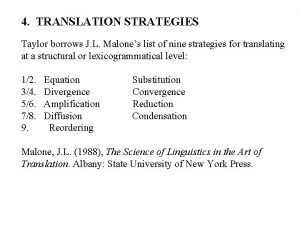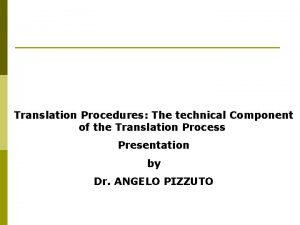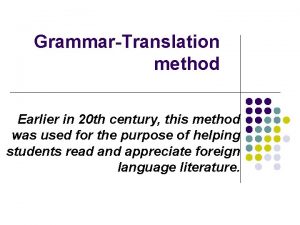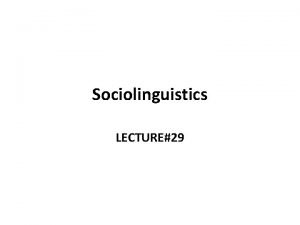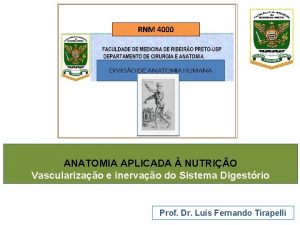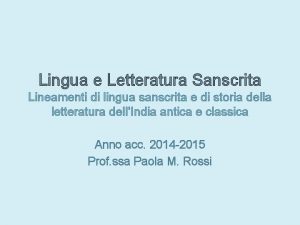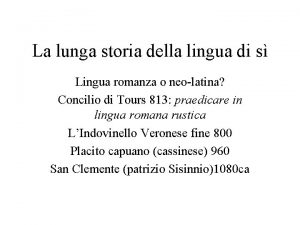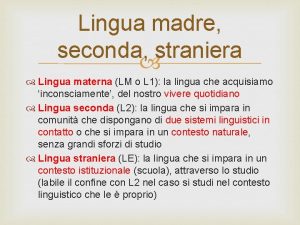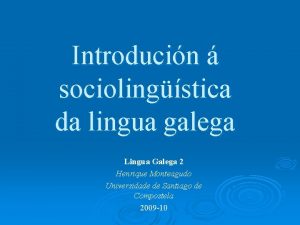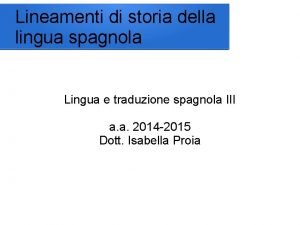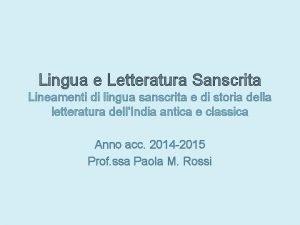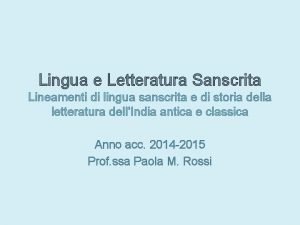TRANSLATION 12 Translation strategies and techniques 2 Lingua


























- Slides: 26

TRANSLATION 12. Translation strategies and techniques (2) Lingua Inglese 2 LM

Malone’s Strategies �Equation v Substitution �Divergence v Convergence �Amplification v Reduction �Diffusion v Condensation �Reordering By referring to these strategies translators can justify adjustments of form depending on the semantic, stylistic and communicative requirements of the TT.

Amplification v Reduction Amplification requires the translator to add some element(s) to lexical elements in the ST to facilitate comprehension. �Collocation gaps: a lexical item in one language requires a co- selected collocate. e. g. hanno interesse a tenere il prezzo basso interest (curiosity) does not give the right meaning. Better is … �they have a vested interest in Translators should not be afraid to amplify. The problem is knowing when you need to do it.

Amplification v Reduction � Amplification is often required to decode ST lexical items whose linguistic, semantic, or cultural components may not be immediately clear, especially with proper nouns: e. g. United lost 4 -0 Manchester United ha perso per quattro a zero dopo Caporetto

Noun phrases �Some noun phrases are easy to work out �It’s a health centre in death valley

Dividing noun phrases Other noun phrases can be harder to divide: �big city problems, i. e. problems of big cities OR big city problems, i. e. big problems of cities You need to understand what modifies what and then make the connection

Division of noun phrases �rural and small town social controls �the exploding divorce rate �The 19 th century sex role system �peace-time western democracies

Division of noun phrases �exchange-rate policies �cell-substratum interactions �tightly multi-layered clusters �dialog box name �horizontal split bar

Amplification in simple noun phrases An English noun phrase may need clarifying in Italian for the reader. This can be done by amplifying a particular lexical item: e. g. “breached duplex” � breached duplex = struttura di duplicazione sconnessa Here the lexical item “duplex” has been amplified to “struttura di duplicazione”

Amplification in complex noun phrases Complex noun phrases may have a combination of amplification and diffusion (see later slides). Amplification is shown in green in three of the following examples.

Amplification (in green) of lexical items in noun phrases in Italian TT �rural and small town social controls �the exploding divorce rate • le limitazioni sociali imposte nelle cittadine e nelle comunità rurali di provenienza • l’impennata del tasso del divorzio �The 19 th century sex • le divisioni dei ruoli in base al sesso nel XIX secolo �peace-time western • democrazie occidentali in tempo di pace role system democracies

Amplification of lexical items in noun phrases in Italian TT (in green) �exchange-rate • linee-guide riguardanti I tassi �cell-substratum • le interazioni tra cellula e lamina basale �tightly multi- • grappoli multistratificati stretti tra loro �dialog box name • nome della finestra di dialogo �horizontal split bar • barra di divisione orizzontale policies interactions layered clusters di cambio

Reduction � Reduction consist of omitting an element in the TT text because it is regarded as redundant, or even misleading. e. g. carta geografica = maps globo terrestre = globe esporre in modo visibile = display Sometimes a translator can use reduction to improve the quality of the ST by making it less redundant

Diffusion �While amplification refers to addition or subtraction of elements to a lexical item to bring out the meaning of the item, diffusion refers to providing elaboration to bring out more general meaning. e. g. Magari! If only I could/ I wish I could! I wish that were the case Here there is no addition of items but a complete reworking of the original

Diffusion Some grammatical forms in Italian have a number of meanings and require diffusion in english: Perfect conditional �La banda avrebbe rapinato altre banche The gang is alleged/ said/ thought/ reported to have robbed three other banks. Imperfect form of dovere �doveva saperelo = he should have known that �This is diffusion because the grammatical structure of the ST has been completely reorganised

Condensation �Condensation entails producing a more economical text in the TT. e. g. q buon prezzo far vedere cheaply show �When Italian is the TT, English prepositional verbs are regularly condensed to a single verb. to make up for/ compensare

Condensation �Condensation is often used to translate Italian sentences marked by verbs, adjectivals, and adverbial or prepositional phrases. e. g. Lo scandalo suscitato dai risultati del rapporto del Ministero dell’Ambiente sull’inquinamento dell’aria In this example “suscitato dai” is not needed in English and is condensed in the English NP: The Environmental Department Air Pollution Report Findings scandal

Diffusion and condensation in a noun phrase Diffusion goes the other way …… e. g. Lo scandalo suscitato dai risultati del rapporto del Ministero dell’Ambiente sull’inquinamento dell’aria ITALIAN Diffusion Condensation ENGLISH The Environmental Department Air Pollution Report Findings scandal

Note – reduction and condensation �Translation of a complex noun phrase can involve both reduction (taking something out of a text because it is redundant) and condensation (making a text more economical) �You usually find more reduction and condensation when you translate from an Italian ST to an English TT And vice versa …

Note – amplification and diffusion � Translation of a complex noun phrase can involve both amplification (adding to a lexical item to bring out its meaning) and diffusion (expanding and reorganising the noun phrase to make the connections in the noun phrase more explicit in order to bring out its meaning ). � You usually find more amplification and diffusion when you translate from an English ST to an Italian TT � Look at the examples of both in the next two slides

Amplification (in green) Diffusion (in brown) �rural and small town social controls �the exploding divorce rate • le limitazioni sociali imposte nelle cittadine e nelle comunità rurali di provenienza • l’impennata del tasso del divorzio �The 19 th century sex • le divisioni dei ruoli in base al sesso nel XIX secolo �peace-time western • democrazie occidentali in tempo di pace role system democracies

Amplification (in green) Diffusion (in brown) �exchange-rate • linee-guide riguardanti I tassi �cell-substratum • le interazioni tra cellula e lamina basale �tightly multi- • grappoli multistratificati stretti tra loro �dialog box name • nome della finestra di dialogo �horizontal split bar • barra di divisione orizzontale policies interactions layered clusters di cambio

Understanding the difference �Amplification and reduction are about adding to and taking away from the meaning of particular lexical items in translation �Diffusion and condensation involve alterations to meaning beyond the lexical level (e. g. how to intepret complex noun phrases), particularly involving grammar.

Reordering • è successa una disgrazia �something • certi lavori li faceva lui �he did some of • non è ancora giunto il tempo �the time has not terrible has happened the work yet come �it is not yet time

Reordering – impersonal to passive • le tigri si trovano in India tigers can be /are found in India you can find tigers in India • i risultati si possono vedere the results can be seen (formal) you can see the results (informal)

Reordering –active to passive • mi hanno detto che … I have been told that …. • possiamo dedurre che it can be deduced that …. • lo stanno interrogando he is being interrogated
 Translation strategies and techniques
Translation strategies and techniques Types of readings
Types of readings Intensive reading definition
Intensive reading definition Counseling strategies and techniques
Counseling strategies and techniques How to write an expository essay
How to write an expository essay Translation loss
Translation loss Malone strategies
Malone strategies Malone translation strategies
Malone translation strategies Semantic and communicative translation examples
Semantic and communicative translation examples Transformations of functions
Transformations of functions Fonctions et solutions techniques
Fonctions et solutions techniques Oblique translation techniques
Oblique translation techniques Prof. karl plotz
Prof. karl plotz Grammar translation method techniques
Grammar translation method techniques Various techniques of managing translation exposure
Various techniques of managing translation exposure Voice translation profile
Voice translation profile Noun to noun
Noun to noun Diferença entre lingua e linguagem
Diferença entre lingua e linguagem Define “lingua franca.”
Define “lingua franca.” Anatomia pâncreas
Anatomia pâncreas Luanda lingua oficial
Luanda lingua oficial Lingua sannita
Lingua sannita Parametros curriculares nacionais lingua portuguesa
Parametros curriculares nacionais lingua portuguesa Sao ko kelle terre
Sao ko kelle terre Nulla est medicina sine lingua latina
Nulla est medicina sine lingua latina Invia est in medicina via sine lingua latina
Invia est in medicina via sine lingua latina Ortocheratinizzato
Ortocheratinizzato






